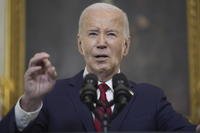The U.S. nuclear weapons complex is in “really bad shape” after the country’s failure to invest in industry and the national laboratories after the Cold War, the top U.S. nuclear commander said.
Air Force Gen. Robert Kehler, head of U.S. Strategic Command, said the U.S. has let the infrastructure that supports the country’s nuclear stockpile slip. He’s confident in the level of funding for the nuclear weapons complex for 2013, but the commitment beyond has left him worried.
“The part of the budget in fiscal year 13 that concerns me the most is the part associated with the nuclear weapons complex, the extended nuclear weapons complex,” Kehler told a crowd Wednesday at the Council on Foreign Relations in Washington D.C.
Kehler took over Strategic Command, which oversees all U.S. nuclear weapons, in 2011 after leading Air Force Space Command for four years. He made it a priority to visit every national nuclear laboratory and the entire nuclear production complex in his first 90 days as commander.
“What I found was confirmation of what I’ve been reading. In some places the infrastructure is in really bad shape -- really bad shape,” Kehler said.
The White House had planned to defer construction on a new plutonium facility in Los Alamos, N.M. However, the House Armed Services Committee reversed that and added $320 billion to the budget to keep it on track.
Kehler said the U.S. has the appropriate amount of funding to meet the 2018 implementation deadline for the new Strategic Arms Reduction Treaty even though some critics say the White House has not lived up to commitments in their budget request.
The Air Force four-star commended Congress for funding nuclear delivery platforms such as the Air Force’s planned long range bomber and the follow on to the Ohio-class submarine. However, he’s more worried about the weapons than the delivery platforms.
The U.S. has long planned for a life extension plan for its B61 nuclear bombs. However, the cost for the program has grown to $4 billion. The White House recommended the military slow down the program and reduced funding for it to $369 million next year.
The House Armed Services Committee has since boosted the funding to $435 million in 2013 to keep the program on track. Kehler said similar investments must be made to maintain intellectual capital in the nuclear weapons complex.
“We do have aging weapons. We do have a series of weapons that are due for life extensions,” Kehler said. “That in and of itself will help the labs to retain and in fact recruit some new, bright, young, shiny kinds of engineers and scientists that they need.”
He acknowledged the political debate over the number of nuclear weapons the U.S. should maintain in its stockpile. No matter if the stockpile grows or shrinks to zero, the U.S. will have to depend on the labs and industry to reach those goals, Kehler said.
“You have to have this enterprise to take care of [nuclear weapons],” he said. “The ’13 budget contains appropriate investment in those activities. What I’m concerned about though is that beyond ‘13 we don’t have a plan that closes.”



























